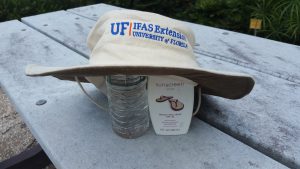
by Samantha Kennedy | Aug 19, 2020
A friend of mine recently shared with me a few recipes for what is known as “cooler corn.” As the name implies, it’s a way of cooking a large amount of corn on the cob all at once inside a cooler, thereby saving time and grill and/or stove space.
At first I was intrigued. I had never heard of this cooking method before and my own personal curiosity was piqued. However, as a certified food safety instructor, I was also immediately horrified. As I reviewed several recipes for this “perfect way to make corn for a crowd,” I became increasingly alarmed. There were so many proper food safety practices violated, it nearly turned my stomach.
Cooking food in a cooler is an unsafe cooking method. Coolers are not designed to withstand the high temperatures required for cooking and cannot adequately hold foods at safe temperatures for prolonged periods of time.
For the record: Cooking corn in a cooler is UNSAFE. The safest ways to cook corn are in a stockpot on the stove, in the oven, or on a grill.
Here are the top four reasons this cooking method is not a good food safety practice:

Cooking food in a cooler is an unsafe cooking method. Coolers are not designed to withstand the high temperatures required for cooking and cannot adequately hold foods at safe temperatures for prolonged periods of time. (Photo source: Samantha Kennedy, UF/IFAS Extension)
1. Coolers are not designed to be used for cooking. The plastic used in coolers is not meant to withstand continued exposure to boiling water and will start to degrade over time. The plastic can also be easily scratched or gouged, providing the perfect place for foodborne pathogens such as Salmonella and E.coli to hide and grow. Think of the other things coolers are used for: storing fish or game after fishing or hunting, keeping drinks cold, storing raw meat or poultry for a picnic, etc. There are so many other opportunities to contaminate the cooler before it is used for cooking corn, even thorough cleaning and sanitation may not be enough to eliminate pathogens. Always keep cooking utensils and tools CLEAN to reduce your risk of foodborne illness.
But what about the boiling water? Won’t that kill any pathogens? Well, yes and no. See #4 below.
And NO, having a cooler dedicated only to cooking corn will not solve all the problems stated above. The bottom line is COOLERS ARE NOT SAFE TO COOK FOOD IN.
2. One of the conveniences of this method, as celebrated in the various recipes, is that people can just reach into the cooler and grab a perfectly cooked ear or two whenever the mood strikes. Allowing people to reach in and grab food like this – especially with their bare hands – is a very unsafe practice. People may forget to wash their hands properly before reaching in, thereby adding dirt and bacteria to the water and thus the food. This type of “germ-sharing” is called cross-contamination and is one of the leading causes of foodborne illness. Always keep things SEPARATE. This includes keeping raw food separate from cooked food, using separate utensils for each food, and reducing or eliminating bare hand contact with food.
3. Stacking dozens of ears of corn in a container and submerging them in boiling water does not ensure that all of the corn will be cooked evenly. The ones in the middle may not be cooked all the way through and there may also be temperature fluctuations in different areas of the cooler because of the way the food is stacked. There may be hot, warm, and cool spots, which can lower the overall temperature to an unsafe level and promote the growth of pathogens. Always COOK foods to the proper minimum internal temperature. In the case of corn, this is 135 degrees F. This can be measured by inserting a properly calibrated food thermometer between two cooked ears of corn and waiting until the needle stops moving.
4. One blog post about the wonders of Cooler Corn stated, “You can leave the corn in there for quite a while after it’s done cooking to keep the ears warm. Since the temperature naturally drops over time, the corn doesn’t get mushy.” When I read this, my mind screamed, “DANGER!” in flashing red letters.
Boiling water is a good sanitizer. However, a lot of what makes it effective for killing pathogens has to do with proper contact time with surfaces AT THE APPROPRIATE TEMPERATURE. Most coolers are not designed to keep boiling water that hot (212 degrees F) for any significant period of time. Even quality coolers will not hold the temperature long enough to ensure proper sanitation and elimination of pathogens.
One of the most important food safety principles is keeping cold foods cold and hot foods hot. To ensure the safety of food, it is important to keep cold foods below 41 degrees F and hot foods above 135 degrees F.
Now think about ears of corn submerged in water for a prolonged period of time, as the water slowly cools. After a while, that water will no longer be able to keep those ears of corn above 135 degrees F. They will basically be sitting in a soup of tepid water at the most favorable temperature for pathogens to grow. The longer the corn sits in that water, the higher the risk of foodborne illness. Always properly CHILL foods to keep them at a safe temperature, below 41 degrees F. The flip side of this coin is to also ensure hot food stays hot, above 135 degrees F.
Cooking for large groups can be a challenge, especially when kitchen space is limited. (Check out the UF/IFAS Extension fact sheet “Food Safety at Tailgating” for more food safety tips when cooking out.) However, it is never a good idea to sacrifice food safety for convenience. Always follow proper food safety practices, no matter the situation, and remember the 4 principles of safe food: CLEAN. SEPARATE. COOK. CHILL.
UF/IFAS in an Equal Opportunity Institution.

by Samantha Kennedy | Jul 16, 2020
An abundance of sunshine is one of the many reasons why so many people love Florida. In fact, it is why we are known as “The Sunshine State.” However, while the sunny days provide tons of opportunities to enjoy the great outdoors, too much sun exposure can lead to minor injury, serious illness, or even death.
The harsh UV rays from the sun can begin to damage the skin in as little as 15 minutes. In fact, even if the skin is not outwardly burned, it may be damaged underneath. Continued unprotected short-term exposure adds up over time, leading to more serious skin damage such as melanoma.

Sunscreen, ample water, and a good hat are all excellent precautions against problems with the summer sun. (Photo source: Samantha Kennedy)
Adopting a few sun safety practices greatly reduces the risk of serious skin damage. One simple practice is the daily application of sunscreen, even on cloudy days, as UV rays can penetrate cloud cover. A minimum Sun Protection Factor (SPF) of 15 is recommended for exposed skin, including lips. Do not use sunscreen past its expiration date, as it may not be as effective.
Eyes should be protected as well, as prolonged exposure to the sun can lead to vision loss or even blindness. Sunglasses which protect against both UVA and UVB rays offer the best protection. Wraparound sunglasses offer the most comprehensive protection of both the eyes and the tender skin surrounding them.
Cover other exposed skin as much as possible with dry, loose-fitting clothing whenever possible, on top of wearing sunscreen. Reapply sunscreen every two hours, especially during continuous sun exposure and after swimming, sweating, and toweling off.
Children under one year of age should be kept out of the sun as much as possible. Keep babies in the shade of a tree, umbrella, or stroller canopy at all times. Older children should follow the same precautions as those given above. Keep in mind, very young children cannot state it is too bright or too hot, so be extra vigilant.
Staying cool and hydrated is also important during those hot summer days. Even those who are acclimated to the climate can easily fall into the dangerous trap of dehydration and overheating. Paying attention to the body’s needs will help prevent heat stress and more serious heat-related illness.
The sun is at its hottest and most brutal between the hours of 10 a.m. and 4 p.m. Reducing outdoor activities between these hours can help reduce the risk of overheating. If this is impossible, be sure to take frequent breaks in a cool, shady spot to help maintain proper body temperature.
Lightweight, light-colored clothing reflects heat better than heavier, darker colors. Hats with wide brims going all the way around are ideal and offer more protection to the ears, neck, and scalp. Baseball caps are fine, but be sure to use a cloth in the back that drapes over exposed skin for more protection.
Drink plenty of fluids constantly. Plain water is the best choice to maintain proper hydration. Avoid alcohol, caffeine, and high amounts of sugar, as these can promote water loss, leading to dehydration. Find a shady spot or an air conditioned space to retreat to periodically throughout the day to keep from overheating.
Some symptoms of heat exhaustion include excessive sweating, confusion, dizziness, weakness, and nausea. Seek shade or air conditioning immediately.
Anyone experiencing an elevated body temperature, hot and dry skin, continued nausea or vomiting, and/or loss of consciousness may be suffering from heat stroke or other severe heat-related illness. Seek medical attention right away.
Florida’s sunshine draws millions of visitors a year. But for visitors and residents alike, it can be dangerous without the proper precautions. By being sun smart, the dog days of Florida’s summer will not take a bite out of the fun.
Resources:
Be Safe in the Sun (American Cancer Society)
Sun Safety (Centers for Disease Control and Prevention)
UF/IFAS is an Equal Opportunity Institution.

by Samantha Kennedy | Jun 11, 2020

Food and water are, with good reason, most people’s priorities when it comes to stocking their hurricane kit. However, other items are important, too, such as first aid items, sanitation supplies, and extra batteries. (Photo source: UF/IFAS File Photo)
It’s officially hurricane season here in Florida and that means it’s time to review and rebuild your disaster kit. Take some time to go through your kit and make sure you have everything you need. Use this checklist as a starting point and add whatever else you may need.
Replace expired food products and replenish your water supply. Need help deciding what kinds of food and how much water to buy? Let this shopping list be your guide! Remember, focus on nutrition. Balanced, nutritious foods will help provide much-needed, long-lasting energy during stressful times. Family and Consumer Sciences agents in Broward County, FL provide a few tips and tricks for making healthy choices.
Need advice about preparing and storing an emergency water supply? This fact sheet can help!
Keep fresh batteries on hand in all the sizes you will need to power your devices, such as flashlights, radios, and other electronics.
Protect important documents. Many items, such as wills, birth certificates, deeds and liens, and insurance papers may be hard to replace if lost or damaged in a storm. Keep hard copies safe in a waterproof, fireproof lock box. Save digital backups in multiple, secure, and portable places that can be accessed after a storm. This fact sheet provides additional tips for protecting your documents and valuables during a disaster.
Create a digital hurricane kit! Alicia Betancourt, Community Resource Development agent in Monroe County, FL, has put together a comprehensive list of online resources that can help you track the storm, stay in touch with loved ones, and plan your evacuation.
Additional Resources
Disaster Handbook (UF/IFAS)
How to Prepare for Emergencies (American Red Cross)
Ready.gov (U.S. Department of Homeland Security)
UF/IFAS is an Equal Opportunity Institution.

by Samantha Kennedy | May 11, 2020
We like to feel as if we are always in control of our lives, especially during a crisis. Being in control provides us with feelings of confidence and strength, as if nothing could ever go wrong. However, sometimes we are not in control of our lives. Sometimes our emotions can run away with us and in times of confusion and uncertainty, those emotions can leave us feeling scared and anxious.
Right now, for many of us, our world has tilted a bit off its axis. We feel as if life is a little precarious, as if the control we value has been threatened. We want to protect ourselves and our families from something we may not fully understand, and this can leave us feeling a bit helpless. While this can be a scary way to feel, let me just say this: It is okay to feel this way, especially during times of challenge and uncertainty.
The key to keeping steady on rough emotional seas is to seek out feelings of calm. Seek out activities that can help distract from the anxious feelings, even for a few minutes. Soothing activities can vary depending on the person, so it is important to find which activities work best. Here are some good examples:

A good book and a soothing cup of tea can provide an oasis of calm in a desert of uncertainty. (Photo source: Samantha Kennedy)
Reading. Books and stories can be a great escape, allowing us to get lost in a world where there are no problems or where, at the very least, the problems are not ours to worry about. When I am feeling anxious, I like to dive into a good mystery or thriller where my mind can become occupied with an intricate plot and I can break the cycle of worried thoughts swirling inside my head. Reading stories with children can help everyone take a break from stress as well.
Creating. Remember those adult coloring books we all bought years ago? Pull those out of the drawer and blow the dust off them. Those items were touted as good stress busters for a reason. Concentrating on coloring in a picture or a pattern can help calm the mind and alleviate stressful emotions. Other creative outlets work just as well, such as drawing, journaling, or playing the guitar. I enjoy practicing my hand lettering when I am feeling stressed.
Exercising. Moving our bodies infuses our muscles and brain with oxygen and releases those feel-good chemicals known as endorphins, which produce feelings of relaxation and euphoria. Exercise strengthens our bodies and boosts our emotions. The exercise does not have to be strenuous to be effective. Low-impact exercise such as yoga and tai chi can have as much of a positive effect on the mind and body as more intense exercise such as running and weightlifting.
Meditating. Meditation is often thought of as something only practiced by spiritual folks on mountaintops in Tibet. But this is an unfair stereotype. Meditation can be practiced by anyone, even children. At its most basic, it is simply a way to center and calm our mind by focusing on our breath as it moves in and out of our body. By doing this, we can simply acknowledge and quickly dismiss all extraneous thoughts, including anxious and stressful ones, thereby not allowing them to take hold. Effective meditation takes practice, but it does not have to take a long time. Even a short 5-minute meditation can help us find calm in a sea of chaos.
Finding ways to achieve calm during confusing times can help us feel more in control of our lives and can reduce feeling of stress and anxiety. For more suggestions on how to cope with stress, please read the UF/IFAS fact sheet Stress Management: Ways to Cope.
Extension classes are open to everyone regardless of race, creed, color, religion, age, disability, sex, sexual orientation, marital status, national origin, political opinions or affiliations.

by Samantha Kennedy | Mar 19, 2020

The deadline for filing your federal income tax return is April 15, 2020. (Photo source: IRS.gov)
The IRS has identified a new version of a phishing email scam targeting tax professionals. The fake email states the preparer’s EFIN has been put on a temporarily hold and warns the EFIN will be suspended unless the preparers open an embedded document and confirm or deny that they submitted the Form 1040. The embedded “1040” document likely contains malware.
The IRS reminds all tax professionals that they are targets of cybercriminals seeking to steal client data or the practitioners’ identities. Thieves use many variations of phishing emails such as this. The fake emails are characterized by an urgent message (your EFIN will be suspended) and try to entice recipients to open a link or attachment. The IRS urges all tax professionals to be on alert and take security steps to protect their clients and their businesses. Review Publication 4557, Safeguarding Taxpayer Data, for how to be safer.
Some simple steps include:
- Using the multi-factor authentication option offered by tax software to protect accounts from unauthorized access.
- Use strong password protections on all devices.
- Never open suspicious emails, links and attachments may carry malware.
- Use strong security software and keep it updated.
For more information, please visit https://www.irs.gov/.










